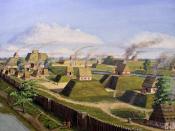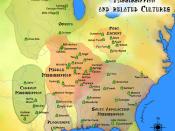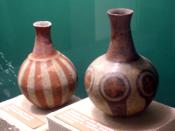A large change in prehistoric Indian culture started to take place just before
1000 A.D. By this time people had lived in the Middle Southeast for over
10,000 years since the first groups of hunters came into this region in persuit
of the bigger animals such as mastadon and bison. Over the years, aboriginal
culture went through many different transitions as the influence from other
areas intensified. The last major wave of such influence just before the
European exploration mad the height of cultural development in the
aboriginal Southeast. The outcome of this transformation is called the
Mississippian culture. This way of life produced such
enormouse and impressive civic-ceremonial sites as Moundville which is
right here in Alabama. In extent of influence, ceremonialism, technology,
architecture, population density,
and the overall richness, the Mississippian development was unmatched in
prehistoric North America.
The Mississippian culture is marked by the appearance of different and
distinctive forms of pottery containing crushed shells in the clay and by the
construction, on and around a kind of central plaza, of large pyramids made
of earth which served as platforms for temples, houses of the higher class or
leaders, and council buldings.
Other important Missippian traits included the
use of the bow, arrows tipped with the smaller triangle shaped stone points,
floodplain agriculture based upon the cultivation of several different plants
like corn, beans, and squash. Religious ceremonialism was connected with
agricultural production therefore centered around a fire-sun deity, long-
distance trade, increased territoriality and warfare, and the emergence of
highly organized chiefdoms.
The major development of the Mississippian culture was in the central
Mississippi Valley where it was by the 700 A.D.. Many archaeologists
beliebe that this area was also the center of origin for the Mississippian
culture, but this has not been proved with...


